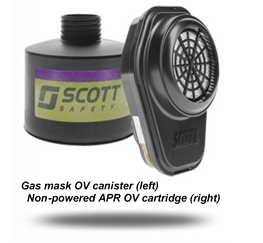The effective service life of any chemical cartridge or canister depends on the conditions of use. Conditions that impact service life are: type and concentration of pesticide as well as other contaminants; user’s breathing rate; relative humidity; and temperature.
For a given pesticide, the higher the concentration of the contaminant gases or vapors, the shorter time to breakthrough. Cartridge/canister service life is also shortened by increased breathing rate when performing more physically demanding tasks. Service life can also be reduced with higher ambient temperature and humidity.
The service life for chemical cartridges/canisters can be identified by chemical-specific end-of-service-life indicators (ESLI), such as a color change indicator on the cartridge or canister. There are a limited number of cartridges and canisters equipped with ESLI, but research and development continue.
In the absence of ESLI, OSHA requires that employers evaluate the conditions of use and pre-determine a changing schedule for replacement of chemical cartridges and canisters per 29 CFR 1910.134(d)(3)(iii)(B)(2). EPA’s Revised WPS adopted this by reference. Pre-determination of a chemical cartridge/canister-change schedule requires knowledge of the pesticide formulation (both active and inactive ingredients); use conditions; and anticipated concentration in the breathing zone.
In the absence of this information, EPA’s Revised WPS requires that gas- or vapor-removing canisters or cartridges be replaced according to respirator manufacturer recommendations or pesticide product labeling instructions, whichever is more frequent.
Respirator manufacturers recommend that OV cartridges/canisters should not be used beyond one day. Organic vapors trapped by the sorbent in the cartridge or canister (see right; photo courtesy of Scott Safety) may easily desorb overnight. If you were to use it the next day, you could breathe in any desorbed pesticide vapors. At the very least, make sure to dispose of OV-purifying elements at the end of the workday.
should not be used beyond one day. Organic vapors trapped by the sorbent in the cartridge or canister (see right; photo courtesy of Scott Safety) may easily desorb overnight. If you were to use it the next day, you could breathe in any desorbed pesticide vapors. At the very least, make sure to dispose of OV-purifying elements at the end of the workday.
Change cartridges/canisters earlier if contaminant odor, taste, or irritation is detected inside the facepiece. Although useful, these sensory indicators should not be the sole determining factor for when a chemical cartridge/canister should be replaced. There is wide variability in sensory thresholds of the general population; some substances are odorless, and individuals can develop olfactory fatigue. Breakthrough may not be detectable by the general population at concentrations that are safe to breathe.
 Source: Respiratory Protection for Occupational Users of Pesticides. Patricia D. Hastings, Coordinator, Rutgers Pesticide Safety Education Program.
Source: Respiratory Protection for Occupational Users of Pesticides. Patricia D. Hastings, Coordinator, Rutgers Pesticide Safety Education Program.